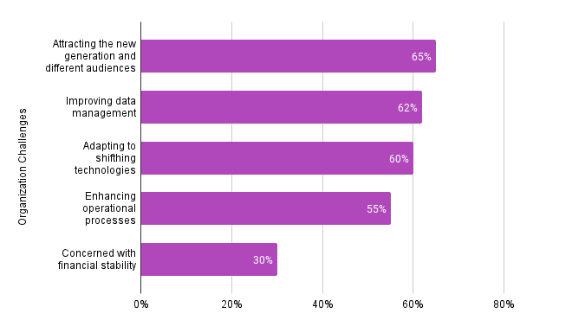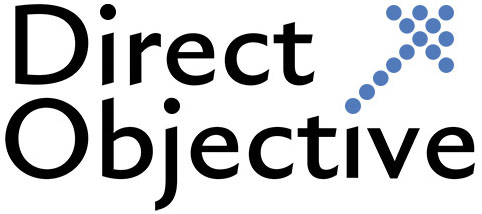Conducting an association audit ensures that new challenges, emerging technologies, and shifting stakeholder expectations are addressed. Direct Objective Consulting administers an annual survey to identify the main challenges that Canadian associations face.
The 2024 survey results highlight the perceived challenges by executives, impacting Canadian associations in 2025. The most pressing concern, cited by 65% of respondents, is attracting the new generation and different audiences, indicating a strong need for renewing engagement strategies. Following closely, 62% of association leaders struggle with improving data management. Adapting to shifting technologies is the next major challenge, affecting 60% of respondents. Additionally, 55% of association executives seek to enhance their operational processes, showcasing a demand for streamlined workflows and increased efficiency.
Interestingly, only 30% of respondents reported financial stability concerns, suggesting that while financial challenges exist, they are not as dominant as other strategic and operational issues. These findings reinforce the importance of continuous adaptation and proactive strategies for association growth.
Now, you need to ask yourself: In what areas does your organization lack effective strategies for reaching its goals?
Association Audit: Is Your Organization Addressing the Real Challenges?
Several questions can help identify areas where you might be struggling:
1. Is Your Value Proposition Still Clear and Compelling?
The value proposition is like a key to a lock. If it matches 100%, the lock opens. Otherwise, it’s going to jam. You need to constantly assess whether the message needs sharpening. Remember, if your value proposition is not clear enough to your prospective members or does not resonate with them, it’s time to adjust it. Staying relevant requires a sharp focus on what truly matters to your members and partners.
2. Are You Reaching the Right People?
Based on Statistics Canada (see diagram below), new generations of leaders and decision-makers are emerging with different priorities and expectations. By 2029, Millennials will outnumber Baby Boomers in the workforce, and Generation Z could outnumber Baby Boomers in 2032. In 2045, Generation Z will make up the majority of workers. If engaging with new generations feels like an uphill battle, your actions might need a revamp.
3. Is Financial Stability a Concern?
Reliable funding is the bedrock of any organization for long-term growth. Over-reliance on traditional revenue streams can jeopardize your financial stability and leave your association vulnerable. Has your organization diversified its revenue sources?
4. Can You Adapt Quickly?
Agility enables your association to identify trends, adapt, and monitor outcomes quickly. Without sufficient actionable data and effective tools, staying ahead of evolving trends becomes challenging. Does your organization collect the right data and have the tools to analyze and make fast but reliable data-driven decisions? An audit of your data infrastructure will help you know your agility level.
Association Audit: Key Success Factors for Long-Term Growth
Once you’ve identified the challenges your organization is facing, it’s time to focus on success factors that can help secure long-term growth. Here are key areas to focus on to ensure your association remains relevant, resilient, and financially stable:
1. Embrace Technology as a Strategic Asset
Technology is more than an operational tool; it’s a strategic enabler. It empowers you to demonstrate value at touchpoints and make a lasting impact on stakeholders. Associations need to leverage advanced technologies, not only to streamline their execution but also to demonstrate value to stakeholders.
By using technologies such as Association Management Software (AMS), Customer Relationship Management (CRM) systems, Members Portal, Learning Management System (LMS), AI, data analytics, and digital engagement platforms, you can offer personalized experiences that resonate with your members. To thrive, you need to make sure you leverage state-of-the-art tools and platforms that can enhance your ability to demonstrate value throughout the stakeholder journey.
Based on the survey results below, we can see that most associations aim to implement AI (Artificial Intelligence) solutions. In this case, AI implementation requires a comprehensive approach that includes high-quality data validity, selecting the right AI model, integrating with existing systems, addressing ethical concerns, and managing security and privacy – all while considering the potential impact on employee or member training needs.
2. Focus on the Data That Matters
We live in an age of data abundance, but not all data is useful. Whether it’s membership demographics or engagement metrics, having the right data at your fingertips can make a considerable difference. Data analytics tools will help you keep up with the latest trends, monitor member engagement, and adjust your actions accordingly. Focus on collecting, analyzing, and leveraging insights that drive quicker and better decisions. The right information at the right time is a game-changer.
3. Explore Diverse Revenue Avenues for Financial Stability
In an increasingly unpredictable environment, relying on a single revenue stream is too risky. Diversification of revenue sources is key to securing long-term financial stability. Look beyond traditional sources and explore new avenues such as partnerships, special sponsor programs, grants, digital products/services, and even alternative models like subscriptions. An association audit can help you identify opportunities for new income streams that align with your organization’s mission and positioning.
4. Establish a Collaborative Approach
No association can succeed in isolation. Collaboration between different stakeholders (board members, staff, volunteers, external partners, etc.) is crucial for building resilience. Encourage open communication, collective problem-solving, and shared decision-making. A collaborative approach ensures that everyone is aligned with the organization’s goals and working together to overcome challenges and seize new opportunities.
5. Align Your Value Proposition with Strategic Directions
As your organization evolves, it’s essential to reassess your value proposition continuously. Does it align with the current needs of your members and the larger industry landscape? Are your goals in sync with broader trends and priorities? By sharpening your positioning message and ensuring it’s tightly aligned with your association’s objectives, you can remain relevant and in demand.
6. Invest in Engagement and Retention
To an association, retention and meaningful engagement aren’t byproducts; they’re goals. Invest in actions that keep your audience engaged. Make sure to monitor the results of your actions constantly. You ensure continuous growth and stability by focusing on retaining existing members and attracting new ones.
What You Gain from an Association Audit

If you’re unsure about your association’s current state and whether you’re on the right path, this could be the solution. Direct Objective’s experts can help assess operational gaps and provide actionable insights that align with your organization’s goals:
- Online Reputation Assessment: Evaluate your digital footprint and online brand perception to understand how your association is perceived digitally.
- Technology Readiness Review: Assess how effectively your organization utilizes technology to support your goals.
- Data Strategy Analysis: Determine if your data strategies support agile decision-making and identify gaps and opportunities for improvement.
- Operational Gap Assessment: The “operational gap” refers to the disconnect between strategy and its successful implementation. This gap prevents the realization of potential goals and results in missed opportunities for growth. By conducting an association audit, you would be able to pinpoint inefficiencies and get actionable insight into how things can be done more efficiently.
Association Audit and The Continuous THRIVE Model
An association audit is a fundamental step in implementing the Continuous THRIVE Model that Direct Objective Consulting developed over the years. It identifies key gaps and opportunities. The Continuous THRIVE Model is a structured and customizable framework to drive organizational growth. The model emphasizes leveraging:
- Technology for agility,
- Utilizing High-quality data for intelligent decision-making,
- Fostering Revenue diversity,
- Promoting Inclusion to engage diverse stakeholders,
- Delivering Value through clear differentiation, and
Maintaining Engaged relationships to boost retention.
Based on the above key areas, Direct Objective Consulting builds the THRIVE Analysis Plan that serves as a roadmap for growth.
The Outcome: Continuous Growth
A resilient, adaptable organization doesn’t just survive; it thrives. By addressing these focus areas, you position your association for long-term, sustainable growth. Ready to future-proof your association? Let us conduct an association audit and suggest a THRIVE Analysis Plan to reach your association’s goals.







